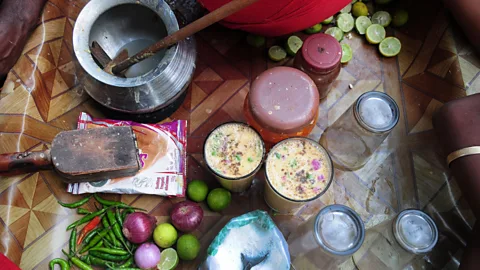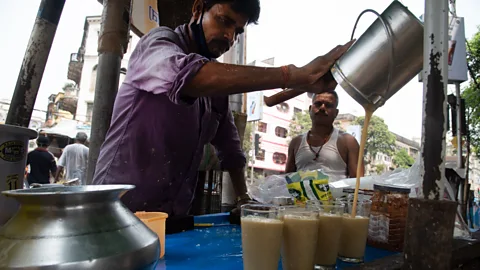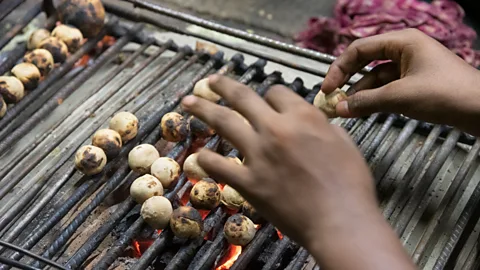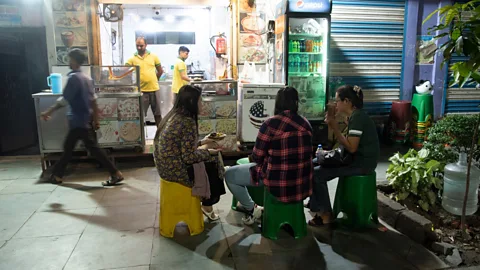India's next big street-food craze?

For years, sattu flour, the main ingredient in a variety of unpretentious street snacks, has remained at the fringes of India's urban foodscape – but now it's going mainstream.
Kishan Yadav poured sattu powder into a steel pot half-filled with water and vigorously stirred the contents with a wooden ladle. He sprinkled the thickening mixture with salt, cumin powder, black pepper and a dash of lemon juice and whisked the beverage to ensure there were no lumps. Then he filled a tumbler with the pale-yellow shake, garnished it with a few onion slices and bright-green coriander leaves and handed it to me.
"Your sattu sherbet is ready," he said with a smile.
A band of his regular patrons – cart pullers and taxi drivers – waited patiently at his roadside kiosk in Kolkata for their own glasses, priced at a modest Rs 10 (£0.11). The cooling drink is an energy powerhouse for these workers. Many of them have come to this city from the states of Bihar and Uttar Pradesh, which are not only the source of a large migrant worker population but also the source of sattu in the first place.
Sattu sherbet has long been a ubiquitous health drink in India, especially popular among the working class in the Northern and Eastern zones, but it – and its main ingredient of sattu powder, made from Bengal gram (chickpeas, or other pulses and legumes) – has remained at the fringes of the urban foodscape. However, over the past couple of years, this flour has risen in popularity, tagged as an epicurean delicacy with a taste of home in upscale restaurants in Indian metropolises, where it is joining the ranks of vegan, gluten-free, so-called "superfoods" such as moringa and millet.
Still, foods made from the beloved flour have historically been consumed for their affordability versus trendiness. Yadav has been selling the sherbet at his stand for more than two decades, and as I sipped my drink, he explained the process of making sattu. Bengal grams are soaked in water, sun-dried and then roasted in a cast-iron pot filled with sand. The grams are then grinded along with the husk to form a fine, yellowish powder. Yadav said that the earthy notes of sattu are formed through this dry-roasting method, which has to be done on a wood-fired stove.
 Sugato Mukherjee
Sugato MukherjeeAccording to food historian Colleen Taylor Sen, author of Feasts and Fasts: A History of Food in India, this process goes back a long way. In her book, she recounts that during the Vedic period (circa 1500-500 BCE) barley seeds were pulverised into a powder called saktu, the predecessor of sattu – and that in medieval northern India, while meat and milk products were reserved for the elite, sattu was a staple for commoners.
Labourers and farmers would mix it with water, salt and green chillies to have a nutritious and inexpensive lunch. "Sattu has been typically associated with the food of working-class migrants from the eastern Gangetic valley [the floodplains along the lower-middle course of the Ganga River, encompassing eastern parts of Uttar Pradesh and Bihar]. Hence it carried low prestige and ranked lower in the urban hierarchy of taste among city dwellers, from middle-class Bengalis of Kolkata to Delhiite professionals," said Krishnendu Ray, associate professor of food studies at New York University and author of several books on food culture.
And this is precisely why sattu has become a political instrument in recent times, used as a symbol of unity within the working class in the eastern Gangetic plains, which constitute a major chunk of the electorate. In 2018, Bihari politician Tej Pratap Yadav organised a sattu party in his constituency, where he talked with the voters and listened to their problems over sattu meals. And in February 2020, a photo of Prime Minister Narendra Modi savouring litti chokha (the signature, sattu-stuffed dough balls emblematic of Bihari cuisine) sparked a heated political debate. While Modi's followers lauded his gesture of giving the dish its overdue acknowledgement, his detractors called his actions a cleverly timed political stunt just before the state elections in Bihar.
 Sugato Mukherjee
Sugato MukherjeeLitti chokha have been my own favourite street snack for a long time, and I have always found the best versions at Nimtala Ghat Street in North Kolkata, a chaotic 1km stretch near the banks of River Hooghly. Here, street shacks rustle up endless tiny littis, flipping them on a tawaa (a flat, metal cooking pan) over a coal or wood fire. At Rs 40 (£0.43), every portion consists of five or six litti balls and a side of chokha (roasted vegetables like eggplant, tomatoes and potatoes). A tangy chutney of green chillies, tamarind, mint leaves and wispy shreds of garlic completes the flavour profile.
"But things have changed a lot over the last few years," said Pankaj Mishra, co-owner of The Litti King, a small restaurant specialising in Bihari cuisine in an upscale neighbourhood of South Kolkata. "When we opened our joint in 2016, we did not imagine that litti chokha and sattu sherbet would be so popular among the well-heeled." Both items now feature on menus for upmarket wedding and plush poolside parties. "Some of the city's top industrialists are our regular patrons," Mishra said.
Food studies professor Ray had an idea as to why. "The new panic about health among elites – associated with over-consumption of junk food and sedentary lifestyles – is now accentuated by Covid and has set them on the pursuit of 'superfoods'," he said. "This is where sattu has come in with its putative protein and micro-nutrient content."
The health-conscious across Indian metros such as Delhi and Bangalore are also discovering the delights of sattu in high-end restaurants, where chefs are adding contemporary spins to the rustic recipes by incorporating grated cheese to the dough or lending a tangy twist with pickles. The trend has caught on in gourmet stores too, where sattu is offered in fancy packaging starting from Rs 190 (about £2) per kg, which is about 2.5 times costlier than the time-tested varieties used in the street stalls.
 Sugato Mukherjee
Sugato Mukherjee"There has been an unprecedented rise in sale of sattu packets in recent months," said Sayoni Samanta, a saleswoman at a South Kolkata outlet of Spencer's, a pan-Indian retail chain. "I think the customers are preferring those products that come with organic and gluten-free labels," she added.
Dr Tulasi Srinivas, a professor of anthropology at Emerson College in Boston, said, "Transformation of dishes like sattu are a kind of elite cultural appropriation and gentrification. For the elite, it's a voyage of discovery whereby they can demonstrate their culinary knowledge of something healthy and 'exotic'. It also works well for the marketers of these 'superfoods'. But what I am glad about is that it is a healthy local food that is getting rediscovered and mainstreamed."
I saw that for myself at Baati Chokha, a fine-dining establishment specialising in Purvanchali (Bihar and Eastern Uttar Pradesh) and North Indian cuisine, located in Salt Lake, Kolkata's preeminent IT hub. On that weekday night at around 22:00, most of the tables were occupied by young office workers. At a table near me, Deepika – an employee at an infotainment firm in the neighbourhood – was fiddling with her phone and taking small, occasional helpings of litti chokha, artfully plated in front of her.
"I come here often for a late-night snack during my breaks," she said, pointing to her half-finished plate. "This was not something I grew up with, so bit of an acquired taste for me. But now I love the earthy flavour of these sattu-filled discs. Easy on my stomach but filling enough to see me through my night shifts. And importantly, its low glycaemic index means no guilt pangs, as was often the case with the junk bites I used to gorge on," she added with a smile.
A few days later, I went back to Yadav's sattu stall to see how felt about his unpretentious street staple going upscale. On that sweltering June afternoon, it was business as usual for him, and he did not seem too interested in sattu's emerging trendiness. “As long as I can provide my customers their glass of sherbet at Rs. 10 [£0.11], I am happy. I only hope all this hullabaloo does not shoot up the prices,” he said. Lallu, a middle-aged cart puller, stood nearby listening attentively. He finished his drink, murmured in agreement and went back to pull his loaded cart from the side of the kiosk on to the busy streets of Kolkata.
---
If you liked this story, sign up for the weekly bbc.com features newsletter called "The Essential List". A handpicked selection of stories from BBC Future, Culture, Worklife and Travel, delivered to your inbox every Friday.
